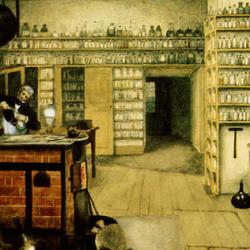According to Lily Gurton-Wachter’s Watchwords: Romanticism and the Poetics of Attention, “the first documentation of the disorder we now call Attention Deficit Hyperactivity Disorder” is found in “a medical text published in London in 1798.” Scottish physician Alexander Crichton described the “morbid alterations to which attention is subject” and highlighted patients who exhibited an “incapacity of attending with a necessary degree of constancy to any one subject” as well as “an unnatural or morbid sensibility of the nerves, by which means this faculty is incessantly withdraw from one impression to another.” Such people were in the grip of what Crichton called “the fidgets” (17).
Crichton disagreed with Thomas Reid’s claim that attention is a purely voluntary act. He discovered that (in Gurton-Wachter’s words) “attention is often involuntary and that to believe otherwise would be considered, by the 1790s, quite ‘unphilosophical’” (17).
Gurton-Wachter thinks it significant that Crichton’s treatise was published in the same year as Lyrical Ballads. The connection is explicit in Wordsworth’s “Preface” to the volume, published in 1800: Wordsworth complained “about a degradation of attention among British readers more pervasive and general than Crichton described. Wordsworth’s famous diagnosis of the ‘state of almost savage torpor’ in the minds of British readers—minds altered by the speed and pace of reading daily newspapers and frantic novels—is a complaint about attention, and an explicit indictment of his own readers’ ‘organs of attention,’ or lack thereof” (18).
The press was partly to blame. Political events also affected British minds: “The fact that Wordsworth blames this communal attention deficit disorder on the ‘great national events which are daily taking place’ and the ‘increasing accumulation of men in cities, where the uniformity of their occupations produces a craving for extraordinary incident, which the rapid communication of intelligence hourly gratifies,’ suggests not just that poetry and newspapers competed for readers’ attentions. Rather, Wordsworth’s point is that the political and social transformations of the period, in conjunction with the new media that documented them, altered how people paid attention altogether” (18).
The momentous events were mainly emanating from France—first the Terror and threat of invasion, then Napoleon. One clue to the links between war and attention is the use of “Attention!” as a military command, first attested in a 1792 field manual of the British War Office. Gurton-Wachter claims that “the Romantic period marked a newly explicit attempt to describe, regulate, and standardize attention for military purposes” (23), not only in the army but throughout British society.
The Romantic poets aimed, she claims, “to derail that process and reappropriate a mode of attention” that was being lost. Wordsworth hoped that poetry—and his poetry especially—would “correct and counter the effects of newspapers, urban life, and politics and how readers pay attention.” Romantic poets traded in the contrast of news-reel A.D.D. and the contemplative attentiveness required by poetry, but Gurton-Wachter describes “a Romantic poetics of attention that, moving beyond a blanket demand for heightened readerly absorption, uses verse form to explore attention’s conditions and its limits, its forcefulness and its finitude.” They experimented “with the rhythms of reading and thus with the media and conditions of receptivity” and encouraged “modes of divided, doubled, and multiplied attention, in which it finds not a liability but a strength,” working out “a rhythm in verse between attention and its relaxation, between watchfulness and its withdrawal” (26).
In this regard, the Romantics do not emerge as thoroughgoing anti-moderns, but as modern poets writing poetry that would be therapeutic to national A.D.D.















